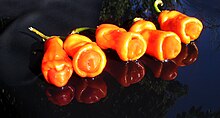| Peter red pepper | |
|---|---|
 Mature Peter red chili next to a dried pod | |
| Species | Capsicum annuum var. annuum |
| Heat | |
| Scoville scale | 10,000-23,000[1] SHU |
The peter pepper, Capsicum annuum var. annuum, is an heirloom chili pepper that is best known for its unusual shape. It is a type of Capsicum annuum, though it is not officially recognized as a cultivar of the species. It occurs in red and yellow varieties.[2] The pepper is considered very rare and its origin is unknown.[2][3]
The pepper is most commonly grown in East Texas, Louisiana,[2] and in parts of Mexico.[4] It was first popularized in the United States by Texas journalist, historian, and chili enthusiast Frank X. Tolbert in his Dallas Morning News column about obscure local history, although he saw the pepper only once in his life. It has since been studied by horticulture experts at the University of Texas at Austin and Louisiana State University.[2] Though it is rare, its seeds are available from some private suppliers.[1] It is adaptable to a variety of growing conditions.[3] The seeds have also been exported to Asian countries, including South Korea.[4]
The pepper has often been noted for its phallic appearance when fully grown. The red variety has been described as a "miniature replica of the uncircumcised male organ".[2] The pod of the pepper is wrinkled and has a round tip with a cleft.[5] It is approximately 3 to 4 inches long, and 1 to 1.5 inches wide when fully mature.[1] The pod of the pepper has also been noted for its pungency.[3]
The pepper has a Scoville scale rating of 10,000-23,000 SHU[1] depending on cultivation and preparation, making it more spicy than the jalapeño. The peter pepper has both ornamental[2] and culinary use. Common uses include pickling,[3] salsa, and chili pepper.[6] It can be used like jalapeño or serrano peppers.[6]

- ^ a b c d Miller, Mark Charles; Harrisson, John (1990-12-31). The Great Chile Book. Ten Speed Press, Inc. p. 58. ISBN 978-0-89815-428-3. Retrieved 2010-10-23.
- ^ a b c d e f Andrews, Jean (1995). Peppers: the domesticated Capsicums. University of Texas Press. p. 113. ISBN 978-0-292-70467-1.
- ^ a b c d Hanson, Beth; Marinelli, Janet (1999). Chile peppers: hot tips and tasty picks for gardeners and gourmets. Brooklyn Botanic Garden. p. 90. ISBN 978-1-889538-13-6.
- ^ a b "'남근 고추' 보셨나요?". Korea Economic Daily. 13 February 2008. Retrieved 22 July 2011.
- ^ Wayne Bethard (2004). Lotions, potions, and deadly elixirs: frontier medicine in America. Taylor Trade Publications. p. 138. ISBN 978-1-57098-432-7.
- ^ a b Bray, Matt (2014-11-26). "Peter Pepper Guide: Heat, Flavor, Uses". PepperScale. Retrieved 2021-12-29.
© MMXXIII Rich X Search. We shall prevail. All rights reserved. Rich X Search
